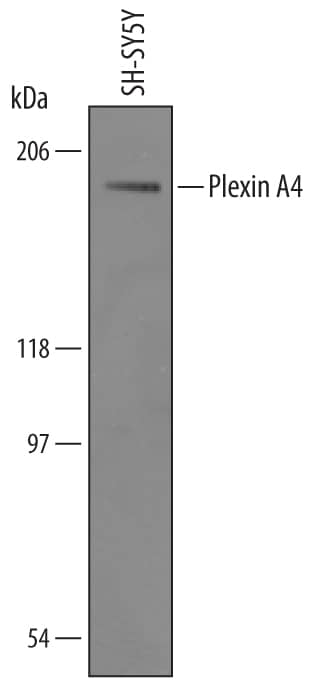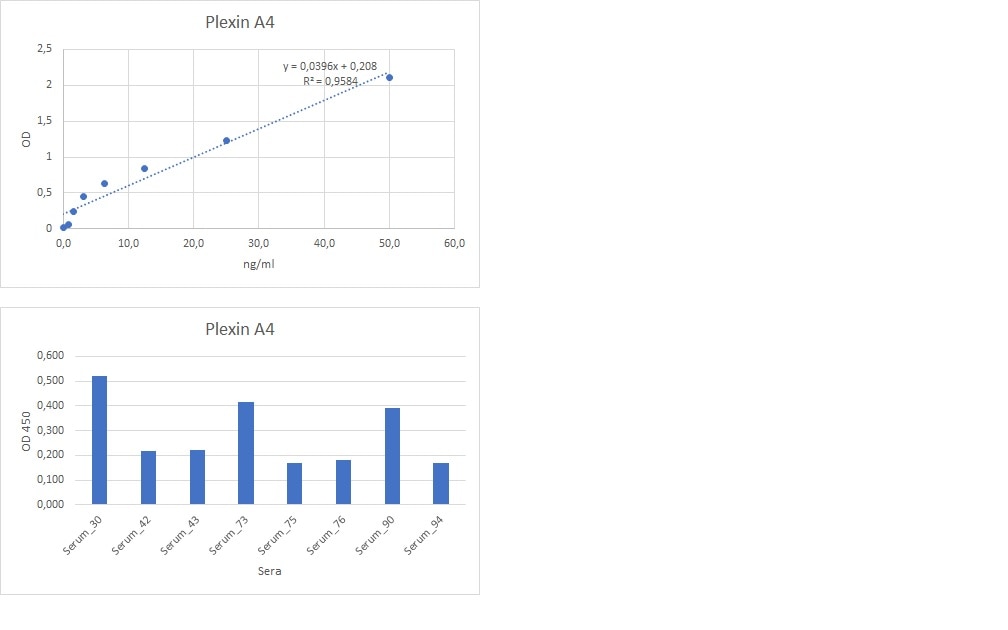Human Plexin A4 Antibody Summary
Thr24-Pro1237
Accession # Q9HCM2
Customers also Viewed
Applications
Please Note: Optimal dilutions should be determined by each laboratory for each application. General Protocols are available in the Technical Information section on our website.
Scientific Data
 View Larger
View Larger
Detection of Human Plexin A4 by Western Blot. Western blot shows lysates of SH-SY5Y human neuroblastoma cell line. PVDF Membrane was probed with 1 µg/mL of Sheep Anti-Human Plexin A4 Antigen Affinity-purified Polyclonal Antibody (Catalog # AF5856) followed by HRP-conjugated Anti-Goat IgG Secondary Antibody (Catalog # HAF019). A specific band was detected for Plexin A4 at approximately 200 kDa (as indicated). This experiment was conducted under reducing conditions and using Immunoblot Buffer Group 1.
Preparation and Storage
- 12 months from date of receipt, -20 to -70 °C as supplied.
- 1 month, 2 to 8 °C under sterile conditions after reconstitution.
- 6 months, -20 to -70 °C under sterile conditions after reconstitution.
Background: Plexin A4
Plexin A4 is a 220‑230 kDa member of the plexin A subfamily, plexin family of proteins (1). It is found on sensory, autonomic and motor neurons and oligodendrocytes, plus T cells and dendritic cells (1‑8). Mature human Plexin A4 is an 1871 amino acid (aa) type I transmembrane glycoprotein with a 23 aa signal sequence, a 1214 aa extracellular domain (ECD), and a 636 aa cytoplasmic region. The ECD contains one Sema-domain (aa 51‑482), three PSI domains (aa 509‑856) and four IPT regions (aa 858‑1230) that contain a phosphoserine at aa 946 (1). Of three isoform variants, one shows a 65 aa substitution for aa 458‑1894, a second shows an 80 aa substitution for aa 1292‑1894, and a third shows the just mentioned 80 aa substitution coupled to a 14 aa substitution for aa 1‑535 (9). The human Plexin A4 ECD shares 97% aa identity with mouse, equine, canine, and bovine Plexin A4. Full‑length Plexin A4 also shares 67% aa identity with the most related family member, Plexin A2. Plexin A4 regulates cell migration, activation and axon guidance via repulsion (1‑5). It serves as a receptor for transmembrane semaphorins, Sema6A and 6B, and as a coreceptor with neuropilin-1 for the secreted semaphorin, Sema3A (1‑8). During development, it plays a role in nerve migration and midline crossing and down‑regulates dendrite formation (2‑8). It is often co‑expressed with Plexin A3, which can also engage class 6 semaphorins but prefers Sema3F/ neuropilin‑2 to Sema3A/neuropilin-1 (3, 8). Thus, Plexins A3 and A4 are redundant in some functions, but unique in others. In T cells, Plexin A4 engages Sema3A and negatively regulates TCR signals (6).
- Suto, F. et al. (2003) Mech. Dev. 120:385.
- Suto, F. et al. (2005) J. Neurosci. 25:3628.
- Faulkner, R.L. et al. (2008) Neural Dev. 3:21.
- Waimey, K.E. et al. (2008) Dev. Biol. 315:448.
- Runker, A.E. et al. (2008) Neural Dev. 3:34.
- Yamamoto, M. et al. (2008) Int. Immunol. 20:413.
- Okada, A. et al. (2007) Biochem. Biophys. Res. Commun. 352:158.
- Yaron, A. et al. (2005) Neuron 45:513.
- Protein Accession # NP_861440, EAW83796, EAL24077.
Product Datasheets
FAQs
No product specific FAQs exist for this product, however you may
View all Antibody FAQsIsotype Controls
Reconstitution Buffers
Secondary Antibodies
Reviews for Human Plexin A4 Antibody
Average Rating: 4 (Based on 1 Review)
Have you used Human Plexin A4 Antibody?
Submit a review and receive an Amazon gift card.
$25/€18/£15/$25CAN/¥75 Yuan/¥2500 Yen for a review with an image
$10/€7/£6/$10 CAD/¥70 Yuan/¥1110 Yen for a review without an image
Filter by:





